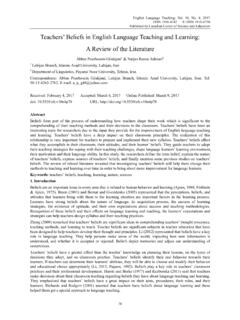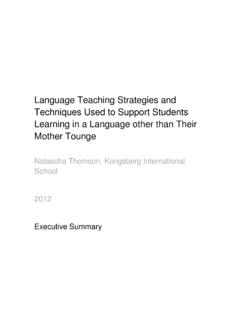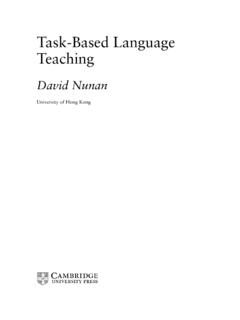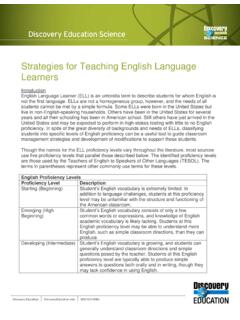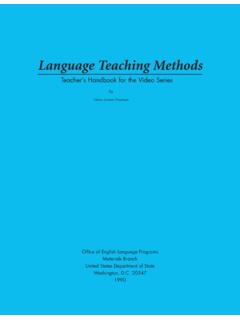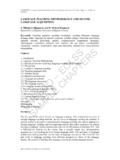Transcription of Language teaching and learning in multilingual classrooms
1 Language teaching and learning in multilingual classrooms Language teaching and learning in multilingual classrooms EUROPEAN COMMISSION Directorate-General for Education and Culture Directorate B Education policy and programme; Innovation, EIT and MSCA Unit Schools and educators; multilingualism E-mail: European Commission B-1049 Brussels Language teaching and learning in multilingual classrooms Prepared by ICF Consulting Services Ltd EUROPEAN COMMISSION Directorate-General for Education and Culture 2015 EN Europe Direct is a service to help you find answers to your questions about the European Union.
2 Freephone number (*): 00 800 6 7 8 9 10 11 (*) The information given is free, as are most calls (though some operators, phone boxes or hotels may charge you). More information on the European Union is available on the Internet ( ). Luxembourg: Publications Office of the European Union, 2015 ISBN 978-92-79-51830-0 doi: European Union, 2015 Reproduction is authorised provided the source is acknowledged. Photo (cover): Disclaimer This document has been prepared for the European Commission; however, it reflects the views only of the authors, and the Commission cannot be held responsible for any use which may be made of the information contained therein.
3 5 Education and Training Table of Contents Table of Contents .. 5 Terms and 8 Executive summary .. 9 Focus of this study .. 9 The challenge .. 9 9 Reception and integration .. 10 Access to the curriculum .. 11 Developing mother tongue competences .. 11 Teacher 12 Conclusions: What will make a difference?.. 12 Recommendations: What will facilitate making a difference? .. 14 Introduction .. 16 Purpose of this research .. 16 Context .. 16 EU policy .. 16 Commission guidance and support within the Open Method of Coordination (OMC).. 17 The educational achievements of migrant children.
4 18 The growth and extent of multilingual 22 National policies and 25 Method .. 26 Broad 26 27 Approach .. 28 A framework for the review of evidence and this report .. 29 Reception and integration .. 30 Access to the curriculum .. 30 Developing mother tongue competences .. 30 Teacher 30 Theme 1: Reception and 31 Participation in early childhood education and care .. 31 Research evidence .. 31 Practitioners views and experience .. 32 Lessons for policy and 33 Placement and 34 Research evidence .. 34 Practitioners views and experience .. 34 Lessons for policy and 36 Assessment of Language support 36 Research evidence.
5 36 Practitioners view and experience .. 37 Lessons for policy and 38 learning the Language of instruction for integration into the school system .. 39 Research evidence .. 39 Practitioners views and experience .. 40 Lessons for policy and 42 Key summary points .. 42 Participation in ECEC .. 42 Placement and admission .. 42 6 Education and TrainingAssessment of Language support needs .. 43 learning the Language of instruction for integration into the school system .. 43 Theme 2: Access to the curriculum .. 44 Support in the classroom for Language and subject learning .. 44 Research evidence.
6 44 Practitioners views and experience .. 45 Lessons for policy and 46 Support outside the 47 Research evidence .. 47 Practitioners views and experience .. 48 Lessons for policy and 51 Adapted teaching approaches by class teachers .. 51 Research evidence .. 52 Practitioners views and experience .. 53 Lessons for policy and 54 Parental engagement .. 55 Research evidence .. 55 Practitioners views and experience .. 56 Lessons for policy and 58 Key summary points .. 58 Support in the classroom .. 58 Support outside the 58 Theme 3: Developing mother tongue competences .. 60 Recognising and developing mother tongue competences in informal and non-formal learning .
7 60 Practitioners views and experiences .. 60 Lessons for policy and 63 Developing mother tongue competences in formal 63 Research evidence .. 63 Practitioners views and experience .. 65 Lessons for policy and 71 Key summary points .. 71 Non-formal and informal learning of mother 71 Formal learning of mother tongues .. 71 Theme 4: Teacher education .. 73 Developing Language development skills and cultural competences .. 73 Practitioners views and experiences .. 73 Lessons for policy and 74 Developing skills for teaching children without the Language of instruction .. 75 Research evidence.
8 75 Practitioners views and experience .. 76 Lessons for policy and 78 Key summary points .. 79 Teacher education in Language teaching skills and cultural competences .. 79 Teacher education to develop skills to support children without the Language of instruction in the 79 Conclusions .. 80 Research evidence gaps .. 80 What makes a difference .. 80 What are the factors working against migrant children achieving their potential? 80 What brings about higher attainment and reduced gaps in achievement and progression? .. 81 What increases children s development of their multi-lingual skills.
9 81 What improves inter-cultural education? .. 81 7 Education and Training What facilitates making a difference .. 82 ANNEXES .. 85 Annex 1 Research 85 Annex 2 Bibliography .. 89 8 Education and TrainingTerms and definitions Invariably there are many different terms used in the literature to describe children who have learnt a different Language before they enter education in a country whether that is at the start of compulsory education because they have a learnt a different Language at home or during compulsory education because they are recently arrived migrants from a country where another Language was spoken.
10 In all cases they are expected to learn the Language which is used for instruction and assessment so that they access the curriculum and progress to higher education and employment. In this report, these children will all be described as without the Language of instruction even where they are described differently in the literature being drawn on where many different terms are used depending on the country context. Where they are distinguished generically as being the children of parents who have migrated in the literature (not all of whom will have learnt a different Language at home), they may be described as migrant children.











